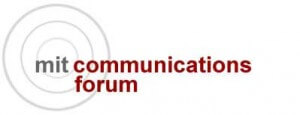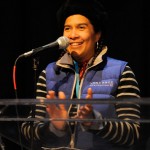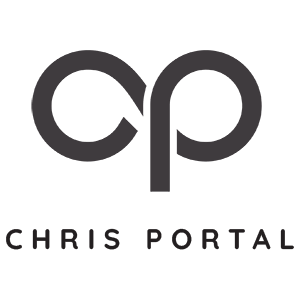 The MIT Communications Forum (MITCF) holds a series of talks every spring and fall on cutting-edge topics involving the cultural, political, economic, and technological impact of communications, with a special emphasis on emerging technologies. They’re organized by MITCF director, David Thorburn, moderated by a guest from the field, and includes a panel of leading scholars, journalists, media producers, and corporate executives.
The MIT Communications Forum (MITCF) holds a series of talks every spring and fall on cutting-edge topics involving the cultural, political, economic, and technological impact of communications, with a special emphasis on emerging technologies. They’re organized by MITCF director, David Thorburn, moderated by a guest from the field, and includes a panel of leading scholars, journalists, media producers, and corporate executives.
Last week, the MITCF held a discussion on how digital technologies are uncovering new ways for creating and conceptualizing documentary films. The discussion lasted about 2 hours, with a panel of 4 participants ranging from academic, funder, festival organizer, and producer. You can listen to the talk here, or download an audio podcast from the MIT Comparative Media Studies site, or video from the MIT Tech TV site.
[divider]
Below are the highlights I took away from the discussion…
Technology Drivers
 The moderater for the event was William Uricchio, professor and director of MIT Comparative Media Studies. While often having been considered “the lame cousin of the feature film”, William pointed out how documentaries have historically been a driver of technology. In fact, 80% of the films made between 1895 (the start of film) and 1905 were documentary. And while “The Jazz Singer” is recognized by the U.S. as the first sound film, William pointed out Germany’s Walter Ruttmann’s “Melodie der Welt”, and Russia’s Dziga Vertov’s “Enthusiasm”, both documentaries, were the first sound films of those countries.
The moderater for the event was William Uricchio, professor and director of MIT Comparative Media Studies. While often having been considered “the lame cousin of the feature film”, William pointed out how documentaries have historically been a driver of technology. In fact, 80% of the films made between 1895 (the start of film) and 1905 were documentary. And while “The Jazz Singer” is recognized by the U.S. as the first sound film, William pointed out Germany’s Walter Ruttmann’s “Melodie der Welt”, and Russia’s Dziga Vertov’s “Enthusiasm”, both documentaries, were the first sound films of those countries.
In fact, new color technology, advances in 16mm film, portable sound, cinema verite – they were all deployed by documentaries. Along the way, each of these technological advances have reimagined the medium, and the relationship between the filmmaker and subject. So with today’s new media and social technologies, William is seeing documentaries once again being the first to adopt and run with these new forms of media. The questions this is raising are many…
[list type=”circle”]
[item]What do we call these documentaries? Do we call them interactive online documentaries, location-based documentaries, transmedia documentaries?[/item]
[item]What is the critical framework for understanding these films and determining what makes one good vs. bad?[/item]
[item]How do we experience them at festivals when they may be better experienced on a laptop?[/item]
[item]What are the ethics involved in techniques such as crowd-sourcing, when media is being created on the backs of others?[/item]
[/list]
[divider]
Is a Documentary App a Documentary?
 Gerry Flahive, producer for the National Film Board (NFB) of Canada, talked about his experience producing two media based documentaries: Waterlife and Highrise, a 4 year media project on how we live around the world. He noted that while the NFB is dedicated to the film director, there is an element of concern in having to take control away from the documentarian in order to give viewers a choice on what path they wish to take their viewing experience down. However, even within those choices, the experience still needs to be creatively defined, so there is still a creative role to fill there. Perhaps it’s not by one person anymore, but it still needs to be created.
Gerry Flahive, producer for the National Film Board (NFB) of Canada, talked about his experience producing two media based documentaries: Waterlife and Highrise, a 4 year media project on how we live around the world. He noted that while the NFB is dedicated to the film director, there is an element of concern in having to take control away from the documentarian in order to give viewers a choice on what path they wish to take their viewing experience down. However, even within those choices, the experience still needs to be creatively defined, so there is still a creative role to fill there. Perhaps it’s not by one person anymore, but it still needs to be created.
Smushing
 Ingrid Kopp is the new media consultant at the Tribeca Film Institute where she runs the TFI New Media Fund (NMF). Compared to the NFB, it’s a different model that involves a straight fund without doing any of the production work themselves. That said, the NMF group is starting to build in additional production support.
Ingrid Kopp is the new media consultant at the Tribeca Film Institute where she runs the TFI New Media Fund (NMF). Compared to the NFB, it’s a different model that involves a straight fund without doing any of the production work themselves. That said, the NMF group is starting to build in additional production support.A New Frontier
 Shari Frilot is the senior programmer for the Sundance Film Festival, and as curator of the New Frontier section, she sees a new frontier to be at play. Facing new frontiers is very much aligned with Sundance’s traditional mission of media discovery. To date, artists have been ahead of the audience for some time, but they’re catching up.
Shari Frilot is the senior programmer for the Sundance Film Festival, and as curator of the New Frontier section, she sees a new frontier to be at play. Facing new frontiers is very much aligned with Sundance’s traditional mission of media discovery. To date, artists have been ahead of the audience for some time, but they’re catching up.Push vs. Pull
 Patricia Zimmermann is a professor in the Department of Cinema, Photography and Media Arts at Ithaca College, and codirector of the Finger Lakes Environmental Film Festival. She sees the current period of media transformation is one that is moving from one to many. From the 1 big feature length film, “the big white whale films” as she calls them, to an ecosystem involving a multiplication of forms and iterations. We’re undergoing a transition from “fixed” to “fluidity” she indicated.
Patricia Zimmermann is a professor in the Department of Cinema, Photography and Media Arts at Ithaca College, and codirector of the Finger Lakes Environmental Film Festival. She sees the current period of media transformation is one that is moving from one to many. From the 1 big feature length film, “the big white whale films” as she calls them, to an ecosystem involving a multiplication of forms and iterations. We’re undergoing a transition from “fixed” to “fluidity” she indicated.
